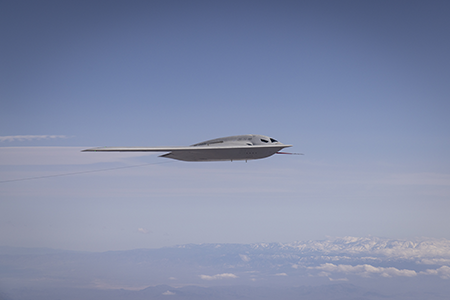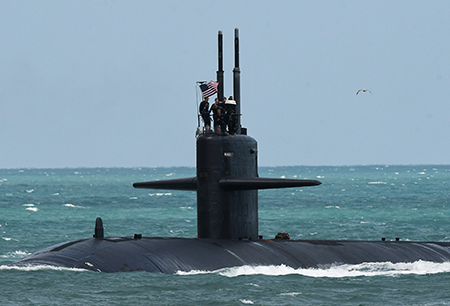“For 50 years, the Arms Control Association has educated citizens around the world to help create broad support for U.S.-led arms control and nonproliferation achievements.”
How to Spend $1 Trillion for the Military?
September 2024
By Jessica Sleight
The next U.S. president will inherit a program to modernize each leg of the U.S. nuclear triad (intercontinental ballistic missiles (ICBMs), submarines, and bombers) to the tune of $1.7 trillion. The program is already marred by delays and overruns, including an 81 percent increase in the cost of the Sentinel ICBM and doubts over the ability of the National Nuclear Security Administration (NNSA) to meet plutonium pit production goals. Additionally, China’s nuclear expansion and Russia’s growing reliance on nuclear coercion have fueled calls for an expanded U.S. nuclear force in the name of deterring two nuclear peer adversaries.

The next president will need to prioritize a rethinking of nuclear strategy that avoids fear-based, short-term thinking; guards against gatekeeping and steamrolling by the military-industrial complex; and takes a holistic approach to strategic deterrence. The decisions made over the next four years will shape the U.S. nuclear arsenal for decades to come.
For former President Donald Trump, the influence of the Heritage Foundation, crafters of Project 2025, cannot be overlooked. A new report by a Heritage expert calls for the nuclear modernization program to be “accelerated and expanded,” including a new road-mobile ICBM, additional nuclear-armed submarines, and new nuclear variants of hypersonic, anti-ship, and intermediate-range missiles.1 It also calls for a small, accelerated nuclear strategy development process; the NNSA to be put on “wartime footing”; and forgoing some safety and environmental regulations in order to move quickly.
There is little justification for such steps, aside from an ambiguous “deterrence gap,” and no real consideration of budgetary impacts. Nevertheless, a second Trump administration likely would have little hesitancy with implementation, having previously introduced new capabilities, including a low-yield warhead for sea-based nuclear missiles. Following up with recommendations from the Heritage report would increase the bloated nuclear budget, threaten to replicate past harms to communities and the environment, further isolate nuclear decision-making, and place the United States squarely in a new nuclear arms race.
As a U.S. senator, Vice President Kamala Harris opposed the development of new low-yield nuclear warheads and encouraged broad interagency input into nuclear strategy development.2 As vice president, Harris has not had much presence on these issues, indicating that her potential administration may follow the Biden administration’s lead.

Recently, Biden officials announced a new strategic review and consideration of options to increase deployed nuclear weapons and other adjustments to U.S. posture to address the new threat environment.3 This comes on the heels of the 2023 report produced by the bipartisan Congressional Commission on the Strategic Posture of the United States, which deemed the current modernization program “necessary but not sufficient.”4 Although the new strategic review is necessary, such efforts traditionally fall victim to momentum, tinkering at the margins of strategy development, undervaluing discussion of risks associated with U.S. action, and shutting down perspectives that may threaten current or future programs. It will be important for a potential Harris administration to stand against such practices.
The difference between a modernization program that ensures a credible nuclear deterrent and one that needlessly throws resources at new and additional weapons starts with nuclear strategy. There are additional options for a future administration to consider. For example, taking adversarial forces off the nuclear targeting list could alleviate a so-called need for new nuclear capabilities and decrease incentives for preemptive nuclear use.
It is imperative that the next president demand in-depth analysis of all options and refrain from deferring to those that conflate supremacy with security. Sober analysis of the assumptions, risks, budget implications, impacts on local communities and the environment, and non-nuclear strategic deterrence tools can save the United States from entering an unwinnable arms race.
ENDNOTES
1. Robert Peters, “A Nuclear Posture Review for the Next Administration,” Heritage Foundation Special Report, No. 287 (July 30, 2024), https://www.heritage.org/sites/default/files/2024-07/SR287.pdf.
2. See Edward J. Markey et al., Letter to Rex W. Tillerson, James N. Mattis, and Rick Perry, July 19, 2017, https://www.markey.senate.gov/imo/media/doc/2017-07-19-Markey-letter-State-Energy-DoD-NuclearPostureReview.pdf; “Harris Statement on Vote Against NDAA,” VoteSmart, June 18, 2018, https://justfacts.votesmart.org/public-statement/1257967/harris-statement-on-vote-against-ndaa/.
3. “Nuclear Threats and the Role of Allies: A Conversation With Acting Assistant Secretary Vipin Narang,” Center for Strategic and International Studies, n.d., https://csis-website-prod.s3.amazonaws.com/s3fs-public/2024-08/240801_Narang_Conversation_Secretary.pdf?VersionId=ITu9zdugiGiBfBig7gUEICXnw9nYn9yR (transcript of August 1, 2024, event).
4. Congressional Commission on the Strategic Posture of the United States, “America’s Strategic Posture,” October 2023, https://www.ida.org/-/media/feature/publications/a/am/americas-strategic-posture/strategic-posture-commission-report.ashx.
Jessica Sleight is the Janne E. Nolan Nuclear Security Fellow at the Truman Center for National Policy.
